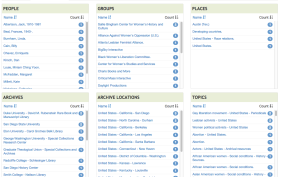First edition of Triple Jeopardy, the newspaper of the Third World Women’s Alliance
I wanted to just make a pitch to everyone to remember that you can find primary sources in rooms beyond those designated as “archives” cultural institutions like the Schomburg: sometimes they are in main collections or (since digitization is happening at an increasing rapid clip) online. You should be inventive and wide-ranging when looking for accessible copies of works you might want to use. For example, following up on Michelle’s Archive Task #1, I was trying to see if there was anyplace in NYC that has papers related to the Third World Women’s Alliance. The main branch of the NYPL (not the “archive” per se) has Triple Jeopardy, the newspaper of the TWWA, in its main collection. However, that journal is also available online in the Independent Voices database.
Independent Voices is an open-access collection of digitized independent publications. It can be a very rich source for Black Power/”post” Black Power and Feminist materials. For example, I found several pieces by Ntozake (also spelled Ntosake) in the database. Since some of you are interested in healing, I have a screenshot of her talking about her work with “injured” women in an extensive interview published in the literary journal, River Styx.

Ntozake’s response to interview questions from Students at Harris-Stowe College in Saint Louis (1978). Note the use of the dash in the interview transcription.
I highly recommend this interview, Shange talks about many of the things you are investigating now: Black Power, Spirituality, Third Worldism, Feminism, childhood, etc. Independent Voices also suggests that you help with digitization by correcting some of the OCR (Optical-Scanning Recognition) errors.
Closer to home, I discovered that the Columbia literary magazine, Emanon, published some of Ntozake Shange’s poetry from when she was a Barnard Student (search Paulette Williams).



